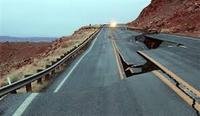-
Fully secure communication
Can worldwide communication ever be fully secure? Quantum physicists believe they can provide secret keys using quantum cryptography via satellite. These physicists have, for the first time, successfully transmitted a secure quantum code through the atmosphere from an aircraft to a ground station.
-
-
Large robotic jellyfish to patrol the oceans

The Office of Naval Research wants to place self-powering, autonomous machines in waters for the purposes of surveillance and monitoring the environment, in addition to other uses such as studying aquatic life, mapping ocean floors, and monitoring ocean currents. Researchers have built a device for that purpose — a life-like, autonomous robotic jellyfish the size and weight of a grown man, 5 foot 7 inches in length and weighing 170 pounds.
-
-
Engineers educate lawmakers about aging U.S. infrastructure

Two hundred members of the American Society of Civil Engineering (ASCE) fanned out across Capitol Hill last month for the annual Legislative Fly-In with a message: U.S. infrastructure problems are solvable if we have strong leadership in Congress. The ASCE members highlighted the nation’s need to eliminate the backlog of infrastructure deficiencies, modernize roads, bridges, water systems, and energy grid – and reminded Congress that to promote commerce and protect public safety, welfare, and the environment, infrastructure investment is a priority issue.
-
-
Americans support preparation for extreme weather, coastal challenges: survey
The challenges posed by rising sea levels and increasingly severe storms will only intensify as more Americans build along the coasts. A just-released NOAA report predicts that already crowded U.S. coastlines will become home to an additional eleven million people by 2020. A Stanford survey finds that the majority of Americans support stronger coastal development codes. Among the most popular policy solutions: stronger building codes for new structures along the coast to minimize damage, and preventing new buildings from being built near the coast.
-
-
Obama promotes private-public infrastructure investment plan
President Barack Obama spent Friday afternoon at the Port of Miami where he announced his plan to attract private investment for big infrastructure projects. One such project is a $2 billion upgrading plan for the port. Obama also he would continue his push for a $100 billion infrastructure bank.
-
-
U.S. water infrastructure is in a serious state of disrepair
The U.S. water system is in a state of disrepair, and is deteriorating further every year for lack of money for maintenance and upkeep. The results include an estimated 240,000 water main breaks each year and nearly 14,000 dams — or one out of every seven dams — in the United States rated as “high hazard,” meaning that the flush of water from a broken dam would likely kill people.
-
-
Draft cybersecurity bill to increase penalties for hacking substantially
A draft of a cybersecurity bill circulating among House Judiciary Committee members would strengthen a computer hacking law. The draft would stiffen penalties for cyber crimes and establish a standard for companies to tell consumers when their personal information has been hacked. The bill would also change an existing law, making a cyber crime attempt punishable as an actual offense.
-
-
U.S. infrastructure grade raised from D to a D+, but problems loom
The American Society of Civil Engineers (ASCE), in its just-released 2013 Report Card for America’s Infrastructure, gave the U.S. infrastructure an overall grade of D+, showing slight progress from the D in the last Report Card issued in 2009. The Report Card concludes that to raise the grades and get U.S. infrastructure to an acceptable level, a total investment of $3.6 trillion is needed by 2020. Currently, only about $2 trillion in infrastructure spending is projected, leaving a shortfall of approximately $1.6 trillion.
-
-
Improved weather, climate predictions strengthen the U.S. economy
The economic costs of damaging weather events have an immense and increasing impact on the U.S. economy. These costs could be anticipated and mitigated by improved weather and climate predictions, say a range of experts in the public and private sectors. These experts will meet in early April in an American Meteorological Society event to discuss the economic benefits of how environmental forecast, prediction, and observation programs and services strengthen the U.S. economy.
-
-
Does warmer climate mean stormier, or only wetter, weather?
Many scientists argue that the climate has warmed since people began to release massive amounts greenhouse gases to the atmosphere during the Industrial Revolution. These scientists, however, are less sure that warming climate creates stormier weather. The reason: nobody has done the quantitative analysis needed to show this is indeed happening. Until now.
-
-
“Dirty blizzard” accounts for missing Deepwater Horizon oil
The Deepwater Horizon disaster spilled more than 200 million gallons of oil into the Gulf of Mexico. Microbes likely processed most of the oil within months of the spill, but these microbes do not account for all of the spilled oil. Scientists have now found what happened to the oil not processed by microbes: the oil acted as a catalyst for plankton and other surface materials to clump together and fall to the sea floor in a massive sedimentation event that researchers are calling a “dirty blizzard.” The oily sediments deposited on the sea floor could cause significant damage to ecosystems and may affect commercial fisheries in the future.
-
-
2012 economic losses from disasters set new record at $138 billion
The UN Office for Disaster Risk Reduction (UNISDR) reported that for the first time in history, the world has experienced three consecutive years in which annual economic losses have exceeded $100 billion. The losses are the result of an enormous increase in exposure of industrial assets and private property to extreme disaster events.
-
-
Building stronger, greener concrete with biofuel byproducts
The world uses nearly seven billion cubic meters of concrete a year, making concrete the most-used industrial material after water. Even though making concrete is less energy intensive than making steel or other building materials, we use so much of it that concrete production accounts for between 3 to 8 percent of global carbon dioxide emissions.
-
-
New structure for regulation of geoengineering research needed: experts
Geoengineering, the use of human technologies to alter the Earth’s climate system — such as injecting reflective particles into the upper atmosphere to scatter incoming sunlight back to space — has emerged as a potentially promising way to mitigate the impacts of climate change. Such efforts, however, could present unforeseen new risks. This inherent tension has thwarted both scientific advances and the development of an international framework for regulating and guiding geoengineering research.
-
-
Predicting landslides

A landslide can seriously injure or even kill people. Now, a new early warning system will be the first to employ geological data in tandem with the latest weather forecasts to provide a concrete warning in emergency situations.
-
More headlines
The long view
Falling Space Debris: How High Is the Risk I'll Get Hit?
An International Space Station battery fell back to Earth and, luckily, splashed down harmlessly in the Atlantic. Should we have worried? Space debris reenters our atmosphere every week.
Using Drone Swarms to Fight Forest Fires
Forest fires are becoming increasingly catastrophic across the world, accelerated by climate change. Researchers are using multiple swarms of drones to tackle natural disasters like forest fires.
